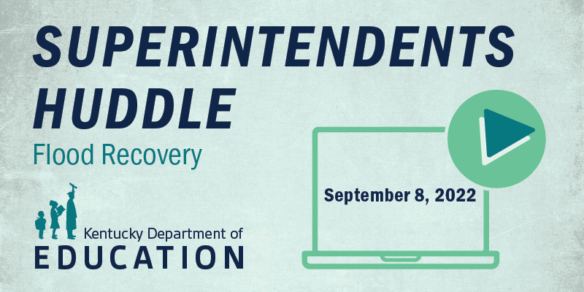
Between displaced families and quarantines due to COVID-19 and other illnesses, superintendents from flood-impacted school districts in eastern Kentucky expressed concerns about lower than average student attendance with Kentucky Department of Education (KDE) leadership at a Sept. 8 virtual meeting.
There also was good news to share as many students in eastern Kentucky returned to school. Breathitt County Superintendent Phillip Watts said school is off to a good start with lots of smiling faces in the hallways.
“I would just like to thank everyone. From donations to visits, it all creates hope, so thank you,” he said.
In Floyd County, Superintendent Anna Shepherd said the district is experiencing one of their “best starts ever.”
“The pandemic separated us in so many ways. This devastation happened, this flooding event, but it’s really pulled our community together,” she said.
Hazard Independent Superintendent Sondra Combs said attendance is now the main concern since her district returned to school on Aug. 18.
“We’ve had quite a few illnesses, not only COVID, but other illnesses – strep (throat) and flu,” she said. “The best place for our kids is in school.”
Shepherd said Floyd County is experiencing one of their “best starts ever” despite attendance being slightly down.
“Our attendance is down somewhat, but some of it is due to COVID with the numbers we are seeing in the area,” she said.
Education Commissioner Jason E. Glass said attendance disruptions are happening across the state and are “exacerbated in the areas that have had flooding impacts.”
“I’m hearing from superintendents across the state about lower than average attendance numbers,” he said. “We typically are 95-96% attendance and we’re hearing lower than that, 90%, and in some places 70-80%.”
Dawson Springs Independent Superintendent Leonard Whalen, whose community in western Kentucky was impacted by tornadoes in December 2021, said his community is still experiencing housing instability, which is impacting attendance. Although homes are being rebuilt, they are not student homes.
“Our attendance is abysmal here in western Kentucky,” he said. “Between COVID and other illness-related things, it’s an issue.”
During a 2021 special session, the Kentucky General Assembly passed Senate Bill (SB) 1, which allows districts to use previous attendance data from either the 2018-2019 or the 2019-2020 school years to calculate the average daily attendance that will be used in calculating SEEK funds and any other state funding based in whole or in part on average daily attendance for the district for the 2021-2022 school year.
The allowance originally was made due to the COVID-19 pandemic and will permit continued funding on this basis only through the 2022-2023 school year. Calculations for state SEEK funding for the 2023-2024 school year will be based upon 2022-2023 average daily attendance.
Whalen continues to advocate for an extended freeze on the SEEK formula and to give districts in both western and eastern Kentucky at least five years to stabilize their communities.
“It’s a lengthy process,” he said. “Once you get past the initial clean-up and get back in school … then you start to look forward and realize some of the challenges out there.”
KDE Associate Commissioner Robin Kinney shared that in the current relief provided to flood-impacted districts through House Bill 1, which passed during the 2022 special session, if a district’s average daily attendance for the 2022-2023 school year decreases by 3% or more than the average daily attendance from the 2018-2019 school year, funding for the 2023-2024 school year can be increased by an amount equal to two-thirds of the decrease.
Glass said KDE is working to find solutions for funding stability and looks forward to working with the General Assembly in January.
In addition to attendance challenges, some districts still are trying to figure out how to restructure bus routes or if they can use alternative transportation, as some roads remain impassable and the distance between schools can span more than 50 miles.
Both Knott County Superintendent Brent Hoover and Jenkins Independent Superintendent Damian Johnson shared their counties have roads that buses cannot go down due to flood damage.
Kinney said KDE is looking into using some of the $213 million disaster relief funding allocated by the General Assembly for school transportation, which may include using some of the $40 million given to KDE for school cleanup, repair and wraparound services.
Return to School Updates
Hoover said Knott County received three tractor trailers full of furniture donations from Jefferson County Public Schools, Fayette County Public Schools and Floyd County Schools.
For the districts that have not yet returned, progress is being made. Letcher County Superintendent Denise Yonts said the district is working “fast and furious” to get their buildings ready for a Sept. 21 start date.
“The outpouring of support from every district in the state has been wonderful,” she said. “I’ve texted superintendents and say, ‘We need this’ or ‘We need that’ and they say, ‘Let me find it,’ Let’s see what we can do to help you,’ and I’m very thankful for that.”
Jenkins Independent has not yet set a definitive start date because of finishing cleanup, but the progress is going smoothly, Johnson said.
The preschool received the most damage and will be housed at the church next the school. Johnson thanked Barren County for donating preschool furniture and Greenup County for donating textbooks.
“We think that we’re less from two weeks from being in, but it all depends on how this goes,” he said. “We’re working as hard as we can. We can’t wait to get back in the building.”
Lt. Gov. Jacqueline Coleman joined the huddle from Breathitt County Schools, where she was visiting with students and school employees and hearing how they were personally impacted.
She also shared with the superintendents a Kentucky Teacher column published on Thursday where she highlighted the work being done by educators in response to both the December tornadoes and July flooding.
“Every time there is a tragedy, people turn to our teachers and our schools,” she said. “I think about the challenges that schools and teachers have had over the last several years … This was my reminder to our communities, when they need their schools and the teachers in them, they answer the call on a normal day they may not know about, but certainly in times of tragedy.”
Update from Kentucky Emergency Management
Also during the meeting, school liaison Valoria Smith from the Kentucky Emergency Management (KYEM) agency discussed the next steps for districts that requested public assistance.
The Federal Emergency Management Agency (FEMA) will assign a Program Delivery Manager (PDMG) – a primary point-of-contact assigned to each district — who will aid the applicant throughout the public assistance process.
The PDMG will conduct an exploratory call with the school districts’ representatives to obtain general information about the applicant and its disaster impacts and explain next steps, she said.
Smith said the main way the PDMGs tell a district’s story is by identifying the disaster impacts through damages to create a public assistance project. She encouraged districts to reach out to her as they begin their projects.
“If I need to put on a pair of jeans and tennis shoes and come and help list items, then I’m coming to help list items,” she said. “Just know that no job is too big or too small.”
KDE has been holding weekly virtual huddles with superintendents of the affected districts since the disaster to provide assistance. The next superintendents’ huddle with KDE will take place on Sept. 15.
MORE INFO …



Leave A Comment